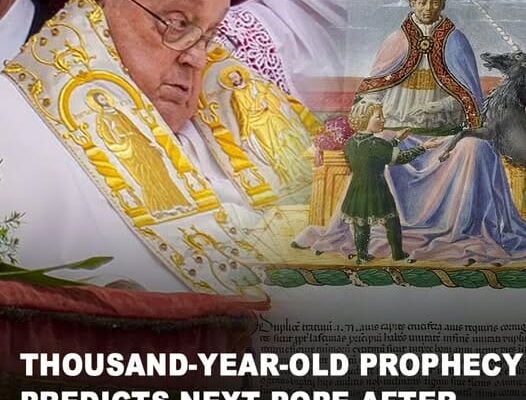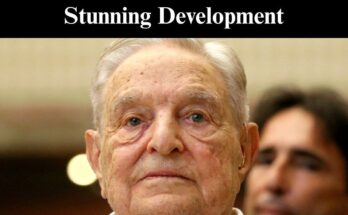Pope Francis’s Death Revives Ancient Prediction — Here’s Why People Are Talking

Thousand-year-old prophecy predicts next Pope after Francis dies… and issues a chilling warning for humanity
Pope Francis’s Death Rekindles Interest in 900-Year-Old Prophecy Regarding His Successor and the End Times

The sudden passing of Pope Francis at the age of 88 has not only plunged the Catholic world into mourning—it has also rekindled one of the Church’s most mysterious legends, stirring both awe and apprehension among the faithful and the curious alike.
Once again, the shadowy Prophecy of the Popes, a 12th-century manuscript cloaked in centuries of secrecy and mystique, has emerged from the depths of Vatican archives. Penned by the Irish archbishop Saint Malachy, the ancient text outlines a cryptic succession of 112 pontiffs, beginning with Celestine II in 1143.
Now, as the final line of the prophecy comes into focus, whispers grow louder. It speaks of a final pope—“Peter the Roman”—who will shepherd the Church through a time of cataclysmic upheaval, leading up to the long-foretold return of Christ. With recent events uncannily echoing the prophecy’s ominous tone, questions linger: was this the beginning of the end, or simply another chapter in a tale the world is only just beginning to understand?

Pope Francis Dies at 88—Prophetic Clock Ticks Toward 2027
Pope Francis passed away quietly on Monday, the result of a brain haemorrhage, according to Vatican officials. His final moments came after months of recurring respiratory issues, marking the end of a deeply influential papacy.
But his death has done more than leave a void at the head of the Catholic Church—it has sent ripples through the corridors of faith, fear, and prophecy.
Less than two years remain until 2027—a year some interpreters of the infamous Prophecy of the Popes believe could mark the end of the current papal line… and the dawn of Judgement Day.
The Prophecy of the Popes: A Terrifying Chronology
Penned in the 12th century and long hidden within the Vatican’s secret archives, the Prophecy of the Popes is said to contain 112 cryptic Latin phrases, each representing a future pope. Over centuries, scholars and believers alike have drawn chilling parallels between the prophecy’s descriptions and the lives and legacies of actual pontiffs.
Now, all eyes turn to the prophecy’s final, most haunting entry.
The last line speaks of “Peter the Roman,” a mysterious figure said to guide the Church during a time of great tribulation and sorrow. It reads:
“In the final persecution of the Holy Roman Church, there will sit Peter the Roman, who will pasture his sheep in many tribulations; and when these things are finished, the city of seven hills will be destroyed, and the dreadful judge will judge his people. The End.”
As the Church prepares to elect its next leader, the world watches with bated breath. Is this merely symbolic… or is prophecy unfolding before our eyes?

The Final Chapter Begins: Prophecy, Power, and the Future of the Church
“The seven-hilled city will be destroyed, and the terrible Judge will judge the people after Peter the Roman, who will feed his flock through many hardships, reigns in the final persecution of the Holy Roman Church.”
So reads the chilling final line of the Prophecy of the Popes, an ancient manuscript that has resurfaced once more—this time, against the backdrop of Pope Francis’s solemn passing.
He died peacefully on Monday from what authorities have identified as a brain haemorrhage, following prolonged struggles with recurring respiratory illness. But as the Church grieves, speculation burns. His death comes alarmingly close to 2027—a date that, in certain interpretations of the prophecy, signals the conclusion of the papal lineage and the onset of Judgement Day.
A Prophetic Timeline—or a Clever Forgery?
The Prophecy of the Popes, attributed to Saint Malachy in the 12th century, outlines 112 cryptic mottos, each believed to correspond to a future pope. While some scholars insist it is a 16th-century hoax crafted to influence papal elections, others argue that the predictions—especially those prior to 1590—are eerily precise.
Take, for instance, the 111th pope, referred to as “Gloria Olivae,” or “The Glory of the Olive.” Many believe this moniker fits Pope Benedict XVI, a member of the Order of Saint Benedict—an order loosely linked to the Olivetans.
Even more haunting is the reference to a pope “of the eclipse of the sun.” Some point to Pope John Paul II, born in 1920 during a solar eclipse, as a possible fulfillment.
And now, with Pope Francis gone, the eyes of the world turn to the final figure: Peter the Roman—the shepherd of tribulation, the harbinger of the end.
The Conclave Approaches
Vatican tradition dictates that the papal conclave be held 15 to 20 days after the Pope’s passing. In this sacred, secretive process, eligible cardinals—those under the age of 80—will gather beneath Michelangelo’s frescoed ceiling in the Sistine Chapel.
To elect a new pontiff, a two-thirds majority is required. And intriguingly, among the nine men most widely discussed as possible successors… three bear the name Peter.
Coincidence? Or destiny echoing through the chambers of the Church?
As incense fills the air and ballots are cast, one question hangs in the silence: Is this the dawn of renewal—or the eve of revelation?

Is the End of a Prophecy Near?
The Vatican Holds Its Breath
As the world mourns the death of Pope Francis, prophecy-watchers are on high alert—and for good reason. Among the top candidates whispered in the halls of the Vatican are three cardinals named Peter, a detail that has sent chills down the spines of those who study the Prophecy of the Popes.
- Peter Erdő of Hungary, a staunch conservative and theological heavyweight.
- Peter Turkson of Ghana, globally respected for championing environmental stewardship and social justice.
- Pietro Parolin, the Italian Cardinal Secretary of State, a seasoned diplomat and master of Vatican statecraft.
Each bears the name “Peter”—and each, in his own way, could fulfill the prophecy’s ominous final entry. Could one of them be Peter the Roman, the pope destined to shepherd the Church through its final tribulations?
A Twist of Ancestry
Curiously, Pope Francis’s birth name—Jorge Mario Bergoglio—contains no “Peter” at all. Yet for some, this detail doesn’t disqualify him as the final pope foretold by Saint Malachy. Born to Italian immigrants in Argentina, Bergoglio’s ancestral roots trace back to the name “di Pietro”—meaning “of Peter.”
For some interpreters, that was enough. They believed Francis himself may have been Peter the Roman in disguise—guiding the Church toward the end foretold nearly 900 years ago.
A Vision of the End
According to legend, Saint Malachy experienced a series of visions during a pilgrimage to Rome in 1139. What he saw, it is said, was every pope who would ever reign—until the end of time.
The manuscript vanished for centuries, reappearing mysteriously in the late 1500s. Since then, it has ignited endless debate, awe, and unease.
One widely shared theory suggests that Pope Sixtus V—elected in 1585, exactly 442 years after Celestine II, the first pope in the prophecy—marked the precise midpoint. If true, then the prophetic clock has been ticking toward its final hour ever since.
As smoke rises soon from the Sistine Chapel and the conclave gathers to cast their votes, one question grows louder in the silence:
Are we choosing the next pope… or witnessing the last?

Countdown to 2027: Is the Prophecy’s Final Hour Approaching?
If the Prophecy of the Popes follows a symmetrical timeline, then the world may be just 20 months away from its final chapter. According to this theory, the midpoint occurred with Pope Sixtus V in 1585—442 years after Celestine II, the first pope listed in the prophecy. That would place the conclusion in 2027.
A compelling 2024 documentary brought renewed attention to this timeline, highlighting a cryptic quote often linked to Sixtus V:
“Axle in the midst of a sign.”
For many scholars and believers, this puzzling phrase is interpreted as a symbolic reference to the prophetic halfway mark—an axle turning history toward its climax.
If these interpretations hold weight, then the turbulent days described in Saint Malachy’s writings may soon be upon us.
The Church Prepares for Change, but Mystery Lingers
Inside Vatican walls, preparations for the next conclave are moving swiftly. Yet emotions remain raw. The passing of Pope Francis marks more than the end of a papal reign—it signals the close of a spiritual era.
Loved by millions for his humility, his progressive theology, and his constant call for mercy and unity, Francis reshaped the role of the modern papacy. His death leaves not just a vacancy in St. Peter’s Chair, but a sense of collective unease about what comes next.
Will the Church elect a leader for a new era—or its final one?
The world watches. The cardinals prepare. And as time ticks toward 2027, the ancient echoes of prophecy grow louder.

The Prophecy of the Popes has once again aroused interest around the world due to its striking resemblance with contemporary events, regardless of whether it is a divine vision, a clever fabrication, or a coincidence.
The similarities are hard to overlook, even for those who reject prophecy.
Thus, the age-old query reappears as the world watches and awaits the College of Cardinals’ decision to choose the 267th pope of the Catholic Church:
Will this be the final pope?



